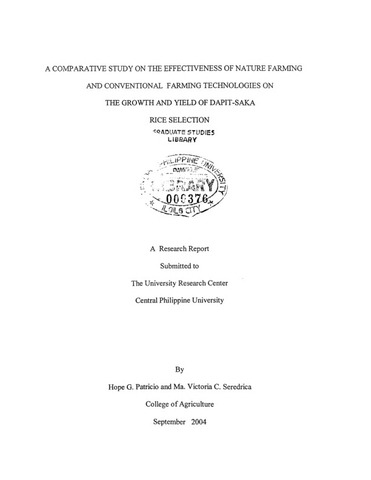A comparative study on the effectiveness of nature farming and conventional farming technologies on the growth and yield of Dapit-saka rice selection
| dc.contributor.author | Patricio, Hope G. | |
| dc.contributor.author | Seredrica, Ma. Victoria C. | |
| dc.date.accessioned | 2021-09-02T01:44:26Z | |
| dc.date.available | 2021-09-02T01:44:26Z | |
| dc.date.issued | 2004-09 | |
| dc.identifier.citation | Patricio, H. G. & Seredrica, M. V. C. (2004). A comparative study on the effectiveness of nature farming and conventional farming technologies on the growth and yield of dapit-saka rice selection (Research report). Jaro, Iloilo City: University Research Center, Central Philippine University. | en_US |
| dc.identifier.uri | https://hdl.handle.net/20.500.12852/1350 | |
| dc.description | Abstract only | en_US |
| dc.description.abstract | Insects found feeding on rice at the early stage, that is, at three weeks after transplanting (WAT) were the rice whorl maggots (Hydrillia philippina), white leafhoppers (Cofana spectra), green leafhoppers (Nephotettix virescens), rice stemborers (Scirpophaga innotata) and grasshoppers (Oxya hyla intricata). Natural enemies observed included a mirid bug (Cytorhinus lividipennis), orange lady beetle (Micraspis crocea), damselfly (Agriocnemis spp.), and spiders (Lynx spiders, Oxyopes spp. ; dwarf spider, Atypena formosana; Orb spider, Argiope catenulate; and long-jawed spider, Tetragnatha maxillosa). It was noted that the use of nature farming technology and the absence of pesticides in the control had attracted more spiders. However, plants grown in conventional farming technology were significantly taller and had the most number of tillers both at maximum vegetative and productive stages. These favorably increased the population of white leafhoppers which likewise favored the surge of insect predators. As the number of insect pests increased on the sixth WAT, a number of species of the natural enemies also increased with the addition of vespid wasps and ground beetle (Ophionea nigrofasciata). The heaviest panicles were produced by plants applied with chemical inputs. These resulted in the highest grain yield of 3,466 kg/ha, a net income of P19,643.00 and an ROI of 130.80% . These values exceeded those of plants in the nature farm technology by 1,641 kg/ha, P14, 737.65, and 94.05 %, respectively. | en_US |
| dc.format.extent | vii, 31 leaves | en_US |
| dc.language.iso | en | en_US |
| dc.publisher | Central Philippine University | en_US |
| dc.subject.ddc | GSL 630.72 P274 | en_US |
| dc.subject.lcsh | Agriculture | en_US |
| dc.subject.lcsh | Organic farming | en_US |
| dc.subject.lcsh | Rice farming | en_US |
| dc.subject.lcsh | Rice--Yields | en_US |
| dc.subject.lcsh | Natural pesticides | en_US |
| dc.subject.lcsh | Natural pesticides--Evaluation | en_US |
| dc.subject.lcsh | Botanical pesticides | en_US |
| dc.subject.lcsh | Botanical pesticides--Evaluation | en_US |
| dc.subject.lcsh | Rice--Growth | en_US |
| dc.subject.lcsh | Rice | en_US |
| dc.title | A comparative study on the effectiveness of nature farming and conventional farming technologies on the growth and yield of Dapit-saka rice selection | en_US |
| dc.type | Technical Report | en_US |
| dcterms.accessRights | Limited public access | en_US |
| dc.description.bibliographicalreferences | Includes bibliographical references | en_US |
| local.subject | Nature farming | en_US |
| local.subject.scientificname | Oryza sativa | en_US |
| local.relation.associatedcontent | https://repository.cpu.edu.ph/handle/20.500.12852/1622 Full paper published in Patubas | en |
Files in this item
This item appears in the following Collection(s)
-
Research reports [167]
-
Research reports [37]


